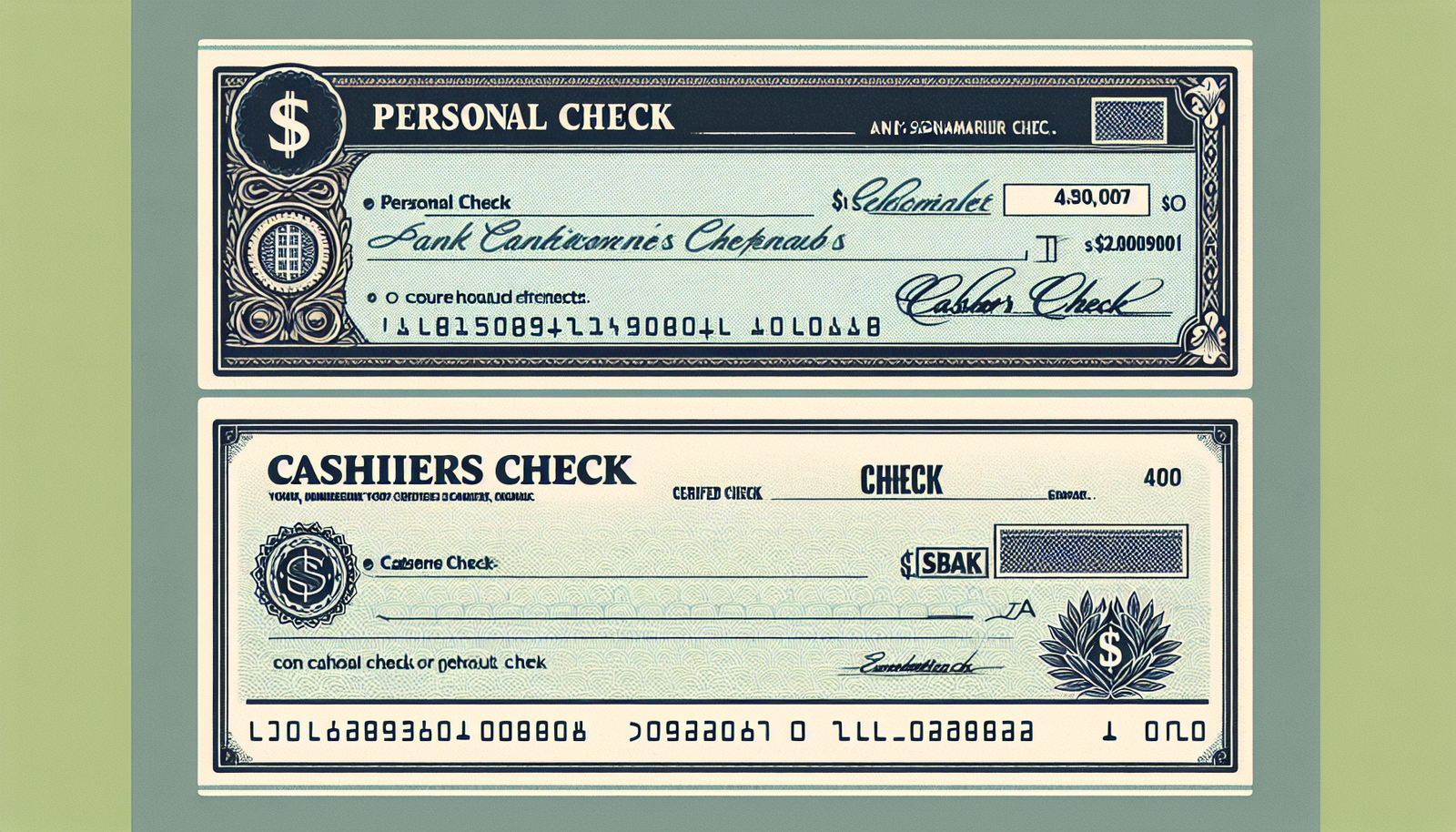
Envision yourself stepping into the world of finance, where the monetary system is as vast as the universe itself. There are galaxies of credit cards and constellations of digital transactions, but today, the three stars we’re focused on are the shining forms of checks: personal, cashier’s, and certified. These three celestial bodies in the financial universe will help you navigate your way through various banking transactions. In the wonderful orbit of fiscal exchanges, understanding these three can make your journey much smoother and more efficient. So put on your space helmet, it’s time to traverse the glittering cosmos of checks.

Basics of Checks
Definition of Check
Let’s initiate our journey with the question, “What is a check?” In simplest terms, a check is a written document that orders a bank to pay a specified amount of money from the issuer’s account to the individual or entity named on the check. Through this process, you can transfer funds without requiring physical currency.
History of Checks
Now, you might be curious about how checks have come into existence. The history of checks dates back to ancient times. In their most primitive form, checks were used by the Romans around 352 BC. However, the modern check has its origins in the 17th century amongst the merchants of London. These early checks were a written confirmation of an agreement to pay and were a safer alternative to carrying around large amounts of cash.
Usefulness of Checks
“Why use checks?” you may wonder. Checks have long been a popular method for making payments due to their safety and convenience. They provide a paper trail and serve as proof of payment. In addition, checks are particularly useful when large amounts of money need to be transferred.
First Type: Personal Checks
Definition of Personal Checks
Getting personal with the first type of check, a personal check is a slip of paper that allows you to pay someone or a company from your personal bank account. You, as the drawer of the check, write it out for the exact amount you owe and the recipient, or payee, can deposit it into their bank account.
Features of Personal Checks
The features that make personal checks unique are simply their usability and personal nature. They are drawn from personal bank accounts and typically includes the drawer’s name, address, and sometimes phone number.
Usage and Acceptance of Personal Checks
Personal checks are often used for direct business between individuals or payments to businesses. These checks are widely accepted; however, keep in mind that due to the potential risk of insufficient funds, some businesses may shy away from accepting personal checks.
Benefits and Drawbacks of Personal Checks
The foremost advantage of personal checks is their convenience. You don’t need to haul around bulky cash or rely on digital means to make a transaction. However, a significant drawback is the potential for bouncing – if you write a check without sufficient funds in your account, the check will “bounce,” and you may incur fees.
Writing a Personal Check
Required Information for Writing Personal Checks
Writing a personal check involves the recording of several critical pieces of information. This includes the date, the payee’s name, the dollar amount in numbers and words, your signature, and a memo (optional) for specifying the payment’s purpose.
Process of Issuing a Personal Check
To issue a personal check, you start by writing the date on the designated line, followed by the name of the recipient in the “Pay to the order of” line. After which, you write the payment amount in numbers near the dollar sign ($) and in words on the line beneath.

Cashing Personal Checks
Process of Cashing Personal Checks
Cashing a personal check is as simple as visiting a bank or a check-cashing store. You’re required to endorse the check by signing your name on the back. Then, you can deposit it into your bank account, or in some cases, receive cash immediately.
Potential Problems with Cashing Personal Checks
Problems can arise while cashing personal checks, such as dishonored checks due to insufficient funds, a closed account, or a suspected fraud. Another issue is that checks sometimes take a few days to clear, meaning you can’t access the funds immediately.
Second Type: Certified Checks
Definition of Certified Checks
A certified check is a type of check for which the bank verifies that there are sufficient funds in the issuer’s account to cover the amount of the check. The bank then “locks” those funds until the check is cashed or deposited.
Features of Certified Checks
The prominent feature of certified checks is the guarantee provided by the bank that the check will not bounce due to insufficient funds. The payer’s signature and a second signature from the bank representative are also unique features of certified checks.
Usage and Acceptance of Certified Checks
Certified checks are typically used for significant transactions, like a down payment on a home. They are widely accepted due to the bank’s verification of funds – reducing the risk for the recipient.
Benefits and Drawbacks of Certified Checks
The significant benefit of certified checks is the added verification which provides a layer of protection for the recipient. On the downside, they may come with additional processing fees from the bank, and there is also a growing threat of certified check fraud.
Issuing a Certified Check
Required information for Issuing Certified Checks
To issue a certified check, you need your identification, your account information, and the exact amount you’re paying. This information is necessary for the bank to verify your account and the amount you wish to pay.
Process of Issuing a Certified Check
The bank will verify your account balance and put a hold on the check amount. Once that’s done, a bank representative will sign the check, certifying it.
Role of Banks in Issuing Certified Checks
Banks play an integral role in issuing certified checks. The process entails verifying the necessary funds, placing a hold on them, and stamping or marking the check to indicate that it’s certified.
Cashing Certified Checks
Process of Cashing Certified Checks
Cashing a certified check is the same as cashing a personal check. You can deposit it in your bank account or use a check-cashing service. The processing time may vary depending on the financial institution.
Potential Problems with Cashing Certified Checks
Again, while rare, it’s possible you might encounter fraudulent certified checks. Also, if a hold was placed on a deposit, you might not have immediate access to all the funds.
Third Type: Cashier’s Checks
Definition of Cashier’s Checks
A cashier’s check, or bank check, is a check written by the bank itself on its funds. It’s signed by the bank representative, and the bank, rather than the person purchasing the check, guarantees the payment.
Features of Cashier’s Checks
Cashier’s checks are considered more secure than personal checks because the funds are guaranteed by the bank itself. Also, cashier’s checks don’t contain personal information like your address or phone number, which is typical of personal checks.
Usage and Acceptance of Cashier’s Checks
Cashier’s checks are often used for large transactions, like buying a house or car, where the payee needs a secure form of payment. They are generally widely accepted, due to the involvement of the bank.
Benefits and Drawbacks of Cashier’s Checks
While cashier’s checks offer security, being drawn directly from the bank’s funds, there are drawbacks. There is a fee to get a cashier’s check. Also, similarly to certified checks, counterfeiting of cashier’s checks is an increasing concern.
Issuing a Cashier’s Check
Required Information for Issuing Cashier’s Checks
When issuing a cashier’s check, you’ll need your identification, your account information, the name of the payee, and the exact amount you’re paying.
Process of Issuing a Cashier’s Check
The bank withdraws funds from your account— or you provide cash— and moves them into the bank’s account. The bank then writes the cashier’s check from its account and signs it.
Role of Banks in Issuing Cashier’s Checks
The role of banks in issuing a cashier’s check is crucial. From taking the depositor’s funds, moving them into the bank’s account, and writing and signing the check, the bank guarantees the payment.
Comparing the Three Types of Checks
Differences in Usage
Personal checks are often used in routine transactions and may not be suitable for large amounts. Certified checks are typically used for significant transactions and are most accepted due to the bank’s verification of funds. Cashier’s checks are for even larger transactions like buying real estate or a vehicle.
Differences in Security Features
With personal checks, the main concerns are insufficient funds or fraud. Certified and cashier’s checks are safer because they involve the bank’s “promise to pay,” but fraud remains a risk.
Acceptance Level of Each Check Type
Personal checks are widely accepted, but not everywhere due to the risk of insufficient funds. Certified and cashier’s checks are generally more accepted due to their association with the bank.
Overall Pros and Cons
Each type of check comes with its advantages and trade-offs. Personal checks are convenient but may be less accepted and pose a risk for fraud. Certified checks require a fee but offer security, while cashier’s checks are backed by the bank’s funds, making them secure but also susceptible to counterfeiting. It comes down to selecting the type of check that aligns best with your needs.

